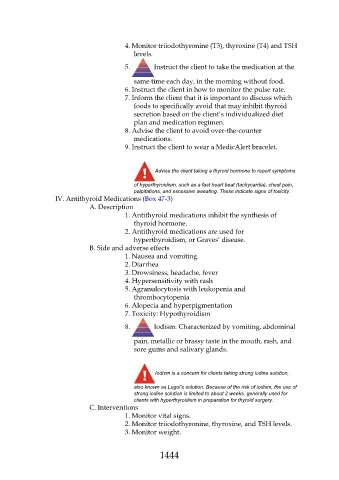Page 1444 - Saunders Comprehensive Review For NCLEX-RN
P. 1444
4. Monitor triiodothyronine (T3), thyroxine (T4) and TSH
levels.
5. Instruct the client to take the medication at the
same time each day, in the morning without food.
6. Instruct the client in how to monitor the pulse rate.
7. Inform the client that it is important to discuss which
foods to specifically avoid that may inhibit thyroid
secretion based on the client’s individualized diet
plan and medication regimen.
8. Advise the client to avoid over-the-counter
medications.
9. Instruct the client to wear a MedicAlert bracelet.
Advise the client taking a thyroid hormone to report symptoms
of hyperthyroidism, such as a fast heart beat (tachycardia), chest pain,
palpitations, and excessive sweating. These indicate signs of toxicity.
IV. Antithyroid Medications (Box 47-3)
A. Description
1. Antithyroid medications inhibit the synthesis of
thyroid hormone.
2. Antithyroid medications are used for
hyperthyroidism, or Graves’ disease.
B. Side and adverse effects
1. Nausea and vomiting
2. Diarrhea
3. Drowsiness, headache, fever
4. Hypersensitivity with rash
5. Agranulocytosis with leukopenia and
thrombocytopenia
6. Alopecia and hyperpigmentation
7. Toxicity: Hypothyroidism
8. Iodism: Characterized by vomiting, abdominal
pain, metallic or brassy taste in the mouth, rash, and
sore gums and salivary glands.
Iodism is a concern for clients taking strong iodine solution,
also known as Lugol’s solution. Because of the risk of iodism, the use of
strong iodine solution is limited to about 2 weeks, generally used for
clients with hyperthyroidism in preparation for thyroid surgery.
C. Interventions
1. Monitor vital signs.
2. Monitor triiodothyronine, thyroxine, and TSH levels.
3. Monitor weight.
1444

